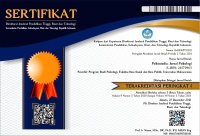Kesatuan dalam Komunitas Kepemudaan: Efektivitas Pelatihan Kecerdasan Emosional dalam Meningkatkan Kohesivitas
Abstract
Keywords
Full Text:
PDFReferences
Adi, W. (2015). Manfaat induction training & intensive building wokshop yang diberikan secara experiential learning di harian kompas. Jurnal Psikologi Indonesia, 6(01).
Arakal, T., & Mampilly, S. R. (2017). The mediating role of group cohesion in the relationship between interpersonal trust and team effectiveness: The derivation grounded on a survey among scientists in research and development organizations. International Journal of Business and Management Invention, 6(1), 16–24.
Carless, S. A., & De Paola, C. (2000). The measurement of cohesion in work teams. Small Group Research, 31(1), 71–88.
Carron, A. V, Widmeyer, W. N., & Brawley, L. R. (1985). The development of an instrument to assess cohesion in sport teams: The group environment questionnaire. Journal of Sport and Exercise Psychology, 7(3), 244–266.
DeOrtentiis, P. S., Summers, J. K., Ammeter, A. P., Douglas, C., & Ferris, G. R. (2013). Cohesion and satisfaction as mediators of the team trust–team effectiveness relationship. Career Development International, 18(5), 521–543.
Forsyth, D. R. (2018). Group dynamics (7th ed.). Cengage Learning.
Goleman, D. (2001). An EI-based theory of performance. The Emotionally Intelligent Workplace: How to Select for, Measure, and Improve Emotional Intelligence in Individuals, Groups, and Organizations, 1, 27–44.
Goleman, D., Boyatzis, R. E., & McKee, A. (2002). The new leaders: Transforming the art of leadership into the science of results.
Kusuma, A. J., Adriansyah, M. A., & Prastika, N. D. (2013). Modal Sosial Terhadap Organizational Citizenship. Jurnal Psikostudia Universitas Mulawarman, 2(2), 100–116.
Lee, C., & Wong, C.-S. (2019). The effect of team emotional intelligence on team process and effectiveness. Journal of Management & Organization, 25(6), 844–859.
Magee, J. C., & Tiedens, L. Z. (2006). Emotional ties that bind: The roles of valence and consistency of group emotion in inferences of cohesiveness and common fate. Personality and Social Psychology Bulletin, 32(12), 1703–1715.
Malik, H. (2008). Teori belajar andragogi dan aplikainya dalam pembelajaran. Jurnal Inovasi, 5(2).
Moore, A., & Mamiseishvili, K. (2012). Examining the relationship between emotional intelligence and group cohesion. Journal of Education for Business, 87(5), 296–302. https://doi.org/10.1080/08832323.2011.623197
Quoidbach, J., & Hansenne, M. (2009). The Impact of Trait Emotional Intelligence on Nursing Team Performance and Cohesiveness. Journal of Professional Nursing, 25(1), 23–29. https://doi.org/10.1016/j.profnurs.2007.12.002
Rapisarda, B. A. (2002). The impact of emotional intelligence on work team cohesiveness and performance. The International Journal of Organizational Analysis, 10(4), 363–379. https://doi.org/10.1108/eb028958
Riggio, R. E. (2017). Introduction to industrial/organizational psychology. Routledge.
Sala, F. (2002). Emotional competence inventory (ECI): Technical manual. In Boston: Hay/McBer Group.
Soboroff, S. (2012). Group size and the trust, cohesion, and commitment of group members. In Graduate College of the University of Iowa. https://doi.org/https://doi.org/10.17077/etd.0mzaq9pd
Troth, A. C., Jordan, P. J., & Lawrence, S. A. (2012). Emotional intelligence, communication competence, and student perceptions of team social cohesion. Journal of Psychoeducational Assessment, 30(4), 414–424. https://doi.org/10.1177/0734282912449447
Whitton, S. M., & Fletcher, R. B. (2014). The group environment questionnaire: A multilevel confirmatory factor analysis. Small Group Research, 45(1), 68–88. https://doi.org/10.1177/1046496413511121
DOI: http://dx.doi.org/10.30872/psikostudia.v10i2.5753
Refbacks
- There are currently no refbacks.
Copyright (c) 2021 Psikostudia : Jurnal Psikologi

This work is licensed under a Creative Commons Attribution-ShareAlike 4.0 International License.
Indexing by :
_________________________________________
PSIKOSTUDIA: Jurnal Psikologi Published by Faculty of Social and Political Siences, University of Mulawarman, Samarinda, East Kalimantan and This work is licensed under a Creative Commons Attribution-ShareAlike 4.0 International License.
_________________________________________
PSIKOSTUDIA: Jurnal Psikologi
Department of Psychology
Faculty of Social and Political Siences, University of Mulawarman
Jl. Muara Muntai Kampus Gn. Kelua Samarinda 75411
Phone: +62 813 35350368
E-Mail: psikostudia@fisip.unmul.ac.id




















